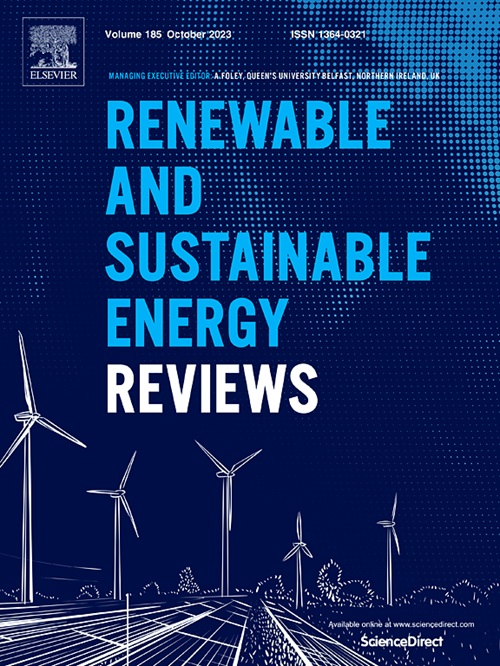利用压电倒旗收集能量
IF 16.3
1区 工程技术
Q1 ENERGY & FUELS
引用次数: 0
摘要
在正确的操作条件下,与进入流体流动对齐的柔性箔,具有自由的前缘和固定的后缘,称为“倒旗”,在旗中产生大量的循环应变,从而产生高幅度的极限循环振荡。这种循环应变,当与压电元件相结合时,可以用作电力的来源。自2013年发明以来,压电倒旗已经逐渐成熟,成为适合小规模应用的能量收集原型,特别是适用于独立安装或分布式网络配置的微传感器。这篇综述对压电倒立旗子进行了批判性的评估,特别关注了在以前的研究中被忽视的重要方面,包括旗子几何形状的变化和压电元件的加入如何影响扑动动力学,设计合适的电力调节电路将旗子收集器与电子设备耦合,与其他更成熟的风能收集解决方案相比,对倒旗发电能力的关键评估。确定并讨论了需要进一步研究的研究空白和主题,以便将倒旗收割机从原型阶段推进到现场应用。本文章由计算机程序翻译,如有差异,请以英文原文为准。
Energy harvesting using piezoelectric inverted flags
A flexible foil aligned to the incoming fluid flow with a free leading-edge and fixed trailing-edge, known as an ‘inverted flag’, under the correct operating conditions performs high amplitude limit-cycle oscillations which cause high amounts of cyclic strain in the flag. This cyclic strain, when coupled with piezoelectric elements, can be used as a source of electric power. Since their invention in 2013, piezoelectric inverted flags have gradually matured into energy harvesting prototypes suitable for small-scale applications, particularly for microsensors, either in stand-alone installations or distributed network configurations. This review provides a critical assessment of piezoelectric inverted flags, devoting special attention to important aspects that have been overlooked in previous investigations, including how the flapping dynamics is affected by changes in the flag geometry and by the inclusion of piezoelectric elements, the design of suitable electric power conditioning circuits to couple flag harvesters with electronic devices, and a critical assessment of the electric power generation capability of inverted flags in comparison with other, more mature, wind energy harvesting solutions. Research gaps and topics that necessitate further investigation to move inverted flag harvesters forward from the prototyping stage to field applications are identified and discussed.
求助全文
通过发布文献求助,成功后即可免费获取论文全文。
去求助
来源期刊

Renewable and Sustainable Energy Reviews
工程技术-能源与燃料
CiteScore
31.20
自引率
5.70%
发文量
1055
审稿时长
62 days
期刊介绍:
The mission of Renewable and Sustainable Energy Reviews is to disseminate the most compelling and pertinent critical insights in renewable and sustainable energy, fostering collaboration among the research community, private sector, and policy and decision makers. The journal aims to exchange challenges, solutions, innovative concepts, and technologies, contributing to sustainable development, the transition to a low-carbon future, and the attainment of emissions targets outlined by the United Nations Framework Convention on Climate Change.
Renewable and Sustainable Energy Reviews publishes a diverse range of content, including review papers, original research, case studies, and analyses of new technologies, all featuring a substantial review component such as critique, comparison, or analysis. Introducing a distinctive paper type, Expert Insights, the journal presents commissioned mini-reviews authored by field leaders, addressing topics of significant interest. Case studies undergo consideration only if they showcase the work's applicability to other regions or contribute valuable insights to the broader field of renewable and sustainable energy. Notably, a bibliographic or literature review lacking critical analysis is deemed unsuitable for publication.
 求助内容:
求助内容: 应助结果提醒方式:
应助结果提醒方式:


